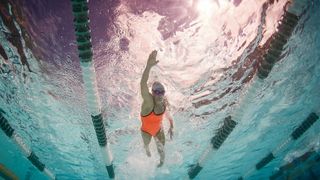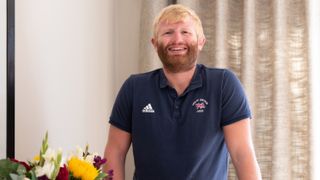Elite Athletes Explain How To Train Twice A Day
It’s daunting, but not impossible, especially if you take advice from these four elite athletes who train at least twice a day

For most people, fitting in a workout every day is a tricky task. Most people are happy to make it to the gym a few times a week.
But if you are looking to take your training to the next level—maybe you’re a CrossFitter aiming to move up the leaderboard during the CrossFit Open, or a keen ultra-marathon runner—you may find your weekly training plan features at least seven sessions.
If you’re wondering how to help your body cope, the best advice we can give is to start thinking like an elite athlete and train like an Olympian.
To help you figure out what that means, Coach spoke to four athletes from various disciplines who train twice a day about their schedules and training styles, and came back with plenty of dos and don’ts.
Lucy Charles-Barclay, World Triathlon Long Distance Champion

If there’s one sport that requires a busy and varied training schedule, it’s triathlon. With three disciplines to train in, it makes sense that elite triathletes might have to train multiple times a day.
Lucy Charles-Barclay is a triathlete and Red Bull athlete, who won the World Triathlon Long Distance Championship in 2022 and became Ironman 70.3 World Champion in 2021.
“I’m training a minimum of two times a day,” says Charles-Barclay. “An easy day for me would be a swim and a gym session—that’s as light as my training will get.”
Get the Coach Newsletter
Sign up for workout ideas, training advice, reviews of the latest gear and more.
A more intense day could comprise a swim in the morning, a three-hour cycle and finally an hour’s run in the evening. “I try to cover at least two of the three sports each day, but if I can only cover one sport, like swimming, then I’ll go and do a solid gym session that will support all three of those disciplines.”
According to Charles-Barclay, her gym sessions are the backbone of her training to keep her strong and injury-free. “With the volume of training I’m doing when I’m preparing for an Ironman triathlon, the injury risk is extremely high,” she says, adding that she also takes recovery extremely seriously, including mobility work, physio and regular massages to her routine.
Charles-Barclay explains that she only takes rest days with no activity the days before and after a race. Otherwise she schedules recovery days that involve light exercise.
Twice-a-day training might be beneficial for intermediate triathlon athletes during the run-up to races, for a specific period of time that’s part of a triathlon training plan that’s managing your training load, and with at least a week before the race where you cut back on training to recover. But Charles-Barclay stresses that this is not suitable for beginners, and she would only suggest training twice a day for intermediate athletes.
Chris Hunt Skelley, Judo Paralympic Gold Medalist

For sports that don’t have multiple disciplines, there are still plenty of benefits to training twice a day, although this doesn’t just mean practicing your sport once in the morning and again in the evening.
Chris Hunt Skelley won Paralympic gold at Tokyo 2020 in judo for the visually impaired, and he combines judo sessions with other activities that support this in order to keep on top of his strength and fitness.
“I train between two to three times a day,” says Skelley. “It doesn’t have to be high-intensity either—it could be an hour-long walk at a good pace, or a sport you enjoy.”
Finding ways to move that you enjoy to keep you fit and strong is crucial, and Skelley says that alongside treating judo as his full-time job, he also does jiu jitsu. He usually does one judo session a day, along with something that will support this, like a strength-based workout, conditioning or a technical session, and then jiu jitsu in the evenings as a hobby.
Like the other athletes, Skelley stresses that recovering from all the training is crucial, and he cites ice baths, compression boots and a massage gun as some of the tools he uses to aid recovery.
Reggie Fasa, CrossFit Athlete And Fittest Man In The UK 2022

CrossFit is a sport made up of a wide variety of disciplines, including weightlifting, gymnastics and conditioning-style workouts. The benefit of CrossFit is that it allows you to practice all these forms of movement within one session.
But elite CrossFit athletes like Reggie Fasa tend to dedicate entire sessions to each discipline, training two or even three times a day to get as strong and fit as possible.
“The off-season is when all the work tends to get done,” says Fasa, explaining that he scales his training down in the weeks leading up to competitions but aims to train multiple times a day during the rest of the year.
If you are an athlete with a competition coming up, Fasa warns against panic training and packing lots of sessions into one day if you usually wouldn’t. “Your fitness is set two or three weeks between the competition,” he says, explaining that suddenly increasing your volume will lead to injury or fatigue.
Fasa takes one full rest day a week, usually on a Sunday, and also uses Thursday as a “down” day, which includes aerobic work such as swimming and zone 2 cardio (also known as low-intensity steady-state cardio or LISS).
He explains that recovery is key to his training routine. “Recovering between your sessions so you can give them the most purpose is key,” he says, adding that planning a routine that is manageable for your schedule and your body in the long term is crucial.
On the five days of the week that Fasa does train intensely, he usually combines two different sessions, one in the morning and another in the afternoon or the evening. His training varies a lot but a typical day might involve a long zone 2 session, followed by a weightlifting workout and rehab. Some days Fasa he will also do two threshold sessions, like rowing followed by a run.
For CrossFit athletes who want to up the volume of their training, Fasa stresses the importance of prioritizing quality over quantity. “It's all about bottling the energy and emotion you need to train so that you get the best out of a session,” he says.
Hannah Walsh, Ultra-running Coach

If you or anyone close to you has ever trained for an ultra-marathon, you’ll know that it is time-consuming. It involves numerous long runs, which can be difficult to fit in around a busy schedule. So is training twice a day the answer?
Hannah Walsh is an ultra-marathon coach who helps women train for seriously long distances, as well as running them herself. “The women I coach are all ‘normal women’—they’re not professional athletes,” she says. “The challenge that I have with these women is finding the time.”
Walsh explains that there are two instances where she’d encourage twice-a-day training. “Firstly, anyone that comes to me and is limited with their volume due to injury,” she says. If someone is coming back from an injury, she explains, it can be potentially dangerous to jump straight back into long runs, so instead, she encourages short runs paired with a bike ride or some cross-training.
She also recommends two sessions a day for people who are training for ultra-marathons on the trails and in the mountains, because strength training for runners is essential. “Often they might have a long run in the morning, have four to six hours’ rest, eat something and then in the evening do a weights session,” says Walsh.
But what about running twice in one day? “If you have the time, I’d always encourage you to get your miles in during one run, rather than splitting them up," Walsh says. Professional athletes might run twice in one day but for amateurs who are training for ultra-marathons, running long distances more than once in a day could lead to injury and fatigue, without proper recovery.

Alice Porter is a journalist who covers health, fitness and wellbeing, among other topics, for titles including Stylist, Fit & Well, Glamour, Cosmopolitan, Grazia, VICE and Refinery29. When she’s not writing about these topics, you can probably find her at her local CrossFit box.
